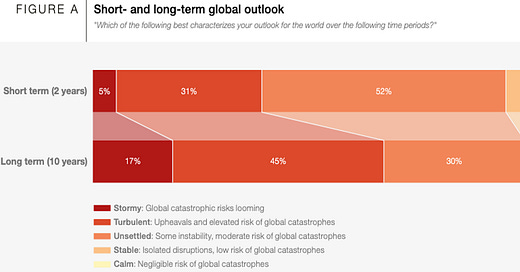Every year I teach the Future Business Challenge, it gives me a fresh perspective on young peoples’ attitudes to the world of work: what they want, what they believe.
Each year they visit a mixture of businesses: some are large, corporate and established, others are startups or very small businesses, with a few in between. The students’ mission is to test each organization for resilience: what capacity do they have to withstand, the thousand shocks they cannot avoid? There are a lot of them now: a tumultuous world of misinformation, disinformation, war, cyber attacks, extreme weather, social polarization. The CEO agenda has never been longer or more complex. So it’s not surprising that the 11,000 business leaders aren’t feeling very optimistic about the future.
But the students—for whom this IS their future—think differently and are far more optimistic than business leaders. Which is good, because expectations drive outcomes; we need them to be serious but also hopeful. And by and large they are.
What companies drew their attention? Those that were trying to use their market power to make the world a better place. The companies they felt to be most resilient take culture seriously, invest in the professional development of their employees and demonstrate a substantial and pragmatic approach to sustainability. For this generation, understanding and addressing climate change has nothing to do with being woke; it has everything to do with being informed, serious and committed for the long term. These students have been aware of environmental degradation their entire lives; their future depends on what we do now and they know it. For them, this is not optional, it is no passing fad. Instead, it is a test of leadership values and competence. They quickly questioned companies whose commitment seemed shallow, hesitant or cautious.
The companies where they wanted to work are not huge; they did not identify resilience with scale. The smaller businesses demonstrated a convincing capacity to adapt; that was fundamental. They all take culture seriously and know that the ability to change, experiment and invent is critical to their future. They were drawn to companies that had a narrative of challenge, reinvention and adaptation. Business-as-usual doesn’t especially excite or persuade them.
On our final day, their presentations bristled with creativity: liberated from templates and instructions, they found fun, insightful ways to describe and analyze their experience. The curiosity and the sheer energy with which they shared their findings was inspiring in itself. Visiting real companies, meeting decision makers: this made all their classroom work come to life. It brought the students to life too. Under pressure to work together, synthesizing a ton of information in a short, intense period of time, they flourished. This is a generation that is frequently demonized : too woke, too delicate, too self-absorbed. But what I saw was 80 bright, energetic students determined to use their minds, their intellectual and physical vigour to face a daunting future with energy, imagination and determination. We need that now.
Want to Go Further?
Read the World Economic Forum’s Global Risks Report each year. It’s essential reading, even if it is scary. You won’t agree with all of it, but it will get your brain whirring.
For the Beauty of It
Between November and February, you can see starling murmurations at the Avalon Marshes on the Somerset Levels. This is a spectacular sight, mysterious and life-enhancing. It will spark a million questions about collaboration, communication and beauty.









Murmurations are simply the greatest thing ever. It’s apt that you include them it in this post. It feels like those students you’ve so lovingly nurtured will head out into the world and together create the same sort of beauty. Bravo
Totally uplifting and informative, thank you Margaret.